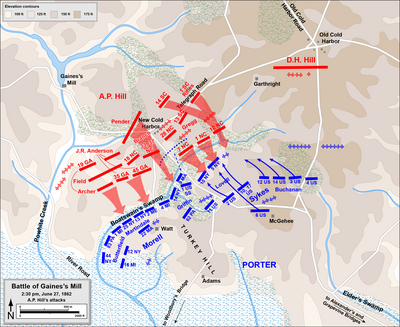McClellan had been badly shaken by Lee's attack on his right in the battle of Beaver Dam Creek. Although he had not suffered a serious reverse, he ordered the troops holding the line, under Fitz John Porter. Even before the battle was over he had written:
I incline to think that Jackson will attack my right and rear. The rebel force is stated at 200,000.... I regret my great inferiority in numbers, but feel that I am in no way responsible for it, as I have not failed to represent repeatedly the necessity of reinforcements; that this was the decisive point, and that all the available means of the Government should be concentrated here. I will do all that a general can do with the splendid army I have the honor to command, and if it is destroyed by overwhelming numbers, can at least die with it and share its fate. But if the result of the action which will probably occur tomorrow, or within a short time, is a disaster, the responsibility cannot be thrown on my shoulders, it must rest where it belongs.McClellan was overestimating the Confederates forces. Although pleased at his victory over Lee, McClellan thought Jackson would strike his rear where he least expected it. The morning after the battle, 150 years ago today, Lee, after finding the Federal position deserted, examined maps and planned his pursuit. He planned for Jackson and D. H. Hill to move around the Federal right, while Longstreet and A. P. Hill pressed on the front. Moving forward, they encountered Federal resistance around Gaines Mill. Lee described the field this way in his report:
The approach to this position was over an open plain, about a quarter of a mile wide, commanded by this triple line of fire and swept by the heavy batteries south of the Chickahominy. In front of his center and right the ground was generally open, bounded on the side of our approach by a wood, with dense and tangled undergrowth, and traversed by a sluggish stream, which converted the soil into a deep morass. The woods on the farther side of the swamp were occupied by sharpshooters, and trees had been felled to increase the difficulty of its passage and detain our advancing columns under the fire of infantry massed on the slopes of the opposite hills and of the batteries on their crests.
 |
| A. P. Hill Attacks |
If you can form an idea of a hundred or more cannon and one hundred thousand or more small arms, and sometimes thousands of men - yelling at the top of their voice - then you can begin to understand the raging terror and the roaring, lumbering noise of this big battle that was going on.
Lee described the course of the battle in his report:
On the right the troops moved forward with steadiness, unchecked by the terrible fire from the triple lines of infantry on the hill, and the cannon on both sides of the river, which burst upon them as they emerged upon the plain. The dead and wounded marked the way of their intrepid advance, the brave Texans leading, closely followed by their no less daring comrades. The enemy were driven from the ravine to the first line of breastworks, over which our impetuous column dashed up to the entrenchments on the crest. These were quickly stormed, fourteen pieces of artillery captured, and the enemy driven into the field beyond. Fresh troops came to his support and he endeavored repeatedly to rally, but in vain. He was forced back with great slaughter until he reached the woods on the banks of the Chickahominy, and night put an end to the pursuit. Long lines of dead and wounded marked each stand made by the enemy in his stubborn resistance, and the field over which he retreated was strewn with the slain.
 |
| Confederate Breakthrough |




0 comments:
Post a Comment